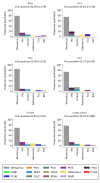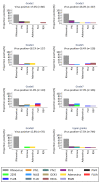Surveillance of respiratory viruses among children attending a primary school in rural coastal Kenya
- PMID: 33102784
- PMCID: PMC7569485
- DOI: 10.12688/wellcomeopenres.15703.2
Surveillance of respiratory viruses among children attending a primary school in rural coastal Kenya
Abstract
Background: Respiratory viruses are primary agents of respiratory tract diseases. Knowledge on the types and frequency of respiratory viruses affecting school-children is important in determining the role of schools in transmission in the community and identifying targets for interventions. Methods: We conducted a one-year (term-time) surveillance of respiratory viruses in a rural primary school in Kilifi County, coastal Kenya between May 2017 and April 2018. A sample of 60 students with symptoms of ARI were targeted for nasopharyngeal swab (NPS) collection weekly. Swabs were screened for 15 respiratory virus targets using real time PCR diagnostics. Data from respiratory virus surveillance at the local primary healthcare facility was used for comparison. Results: Overall, 469 students aged 2-19 years were followed up for 220 days. A total of 1726 samples were collected from 325 symptomatic students; median age of 7 years (IQR 5-11). At least one virus target was detected in 384 (22%) of the samples with a frequency of 288 (16.7%) for rhinovirus, 47 (2.7%) parainfluenza virus, 35 (2.0%) coronavirus, 15 (0.9%) adenovirus, 11 (0.6%) respiratory syncytial virus (RSV) and 5 (0.3%) influenza virus. The proportion of virus positive samples was higher among lower grades compared to upper grades (25.9% vs 17.5% respectively; χ 2 = 17.2, P -value <0.001). Individual virus target frequencies did not differ by age, sex, grade, school term or class size. Rhinovirus was predominant in both the school and outpatient setting. Conclusion: Multiple respiratory viruses circulated in this rural school population. Rhinovirus was dominant in both the school and outpatient setting and RSV was of notably low frequency in the school. The role of school children in transmitting viruses to the household setting is still unclear and further studies linking molecular data to contact patterns between the school children and their households are required.
Keywords: Respiratory viruses; acute respiratory infections; coastal Kenya; nasopharyngeal samples; real-time PCR; school children; school surveillance.
Copyright: © 2020 Adema IW et al.
Conflict of interest statement
No competing interests were disclosed.
Figures







Similar articles
-
Molecular Epidemiology of Human Rhinovirus From 1-Year Surveillance Within a School Setting in Rural Coastal Kenya.Open Forum Infect Dis. 2020 Aug 27;7(10):ofaa385. doi: 10.1093/ofid/ofaa385. eCollection 2020 Oct. Open Forum Infect Dis. 2020. PMID: 33094115 Free PMC article.
-
Surveillance of respiratory viruses in the outpatient setting in rural coastal Kenya: baseline epidemiological observations.Wellcome Open Res. 2018 Jul 25;3:89. doi: 10.12688/wellcomeopenres.14662.1. eCollection 2018. Wellcome Open Res. 2018. PMID: 30175247 Free PMC article.
-
Continuous Invasion by Respiratory Viruses Observed in Rural Households During a Respiratory Syncytial Virus Seasonal Outbreak in Coastal Kenya.Clin Infect Dis. 2018 Oct 30;67(10):1559-1567. doi: 10.1093/cid/ciy313. Clin Infect Dis. 2018. PMID: 29668861 Free PMC article.
-
School knowledge of infectious diseases in schools: conducting surveillance and on-demand, symptomatic respiratory viral testing in a large pre-kindergarten-12th grade school district.Front Public Health. 2024 Jul 23;12:1408281. doi: 10.3389/fpubh.2024.1408281. eCollection 2024. Front Public Health. 2024. PMID: 39109148 Free PMC article.
-
Effects of Non-Pharmacological Interventions on Respiratory Viruses Other Than SARS-CoV-2: Analysis of Laboratory Surveillance and Literature Review From 2018 to 2021.J Korean Med Sci. 2022 May 30;37(21):e172. doi: 10.3346/jkms.2022.37.e172. J Korean Med Sci. 2022. PMID: 35638198 Free PMC article. Review.
Cited by
-
Molecular Epidemiology of Human Rhinovirus From 1-Year Surveillance Within a School Setting in Rural Coastal Kenya.Open Forum Infect Dis. 2020 Aug 27;7(10):ofaa385. doi: 10.1093/ofid/ofaa385. eCollection 2020 Oct. Open Forum Infect Dis. 2020. PMID: 33094115 Free PMC article.
-
Rhinovirus dynamics across different social structures.Npj Viruses. 2023;1(1):6. doi: 10.1038/s44298-023-00008-y. Epub 2023 Nov 27. Npj Viruses. 2023. PMID: 38665239 Free PMC article.
-
Distribution of Viral Respiratory Pathogens During the COVID-19 Pandemic: A Single-Center Pediatric Study from Turkey.Turk Arch Pediatr. 2022 May;57(3):354-359. doi: 10.5152/TurkArchPediatr.2022.21350. Turk Arch Pediatr. 2022. PMID: 35781241 Free PMC article.
-
Respiratory Syncytial Virus Pediatric Hospitalization in the COVID-19 Era.Int J Environ Res Public Health. 2022 Nov 22;19(23):15455. doi: 10.3390/ijerph192315455. Int J Environ Res Public Health. 2022. PMID: 36497528 Free PMC article. Review.
-
Rhinovirus remains prevalent in school teenagers during fight against COVID-19 pandemic.Immun Inflamm Dis. 2021 Mar;9(1):76-79. doi: 10.1002/iid3.381. Epub 2020 Nov 28. Immun Inflamm Dis. 2021. PMID: 33247521 Free PMC article. No abstract available.
References
-
- Legand A, Briand S, Shindo N, et al. : Addressing the public health burden of respiratory viruses: the Battle against Respiratory Viruses (BRaVe) Initiative. Future Virology. 2013;8(10):953–968. 10.2217/fvl.13.85 - DOI
-
- Hammitt LL, Akech DO, Morpeth SC, et al. : Population effect of 10-valent pneumococcal conjugate vaccine on nasopharyngeal carriage of Streptococcus pneumoniae and non-typeable Haemophilus influenzae in Kilifi, Kenya: findings from cross-sectional carriage studies. Lancet Glob Health. 2014;2(7):e397–405. 10.1016/S2214-109X(14)70224-4 - DOI - PMC - PubMed
-
- Dunne EM, Manning J, Russell FM, et al. : Effect of pneumococcal vaccination on nasopharyngeal carriage of Streptococcus pneumoniae, Haemophilus influenzae, Moraxella catarrhalis, and Staphylococcus aureus in Fijian children. J Clin Microbiol. 2012;50(3):1034–8. 10.1128/JCM.06589-11 - DOI - PMC - PubMed
Grants and funding
LinkOut - more resources
Full Text Sources
Miscellaneous

